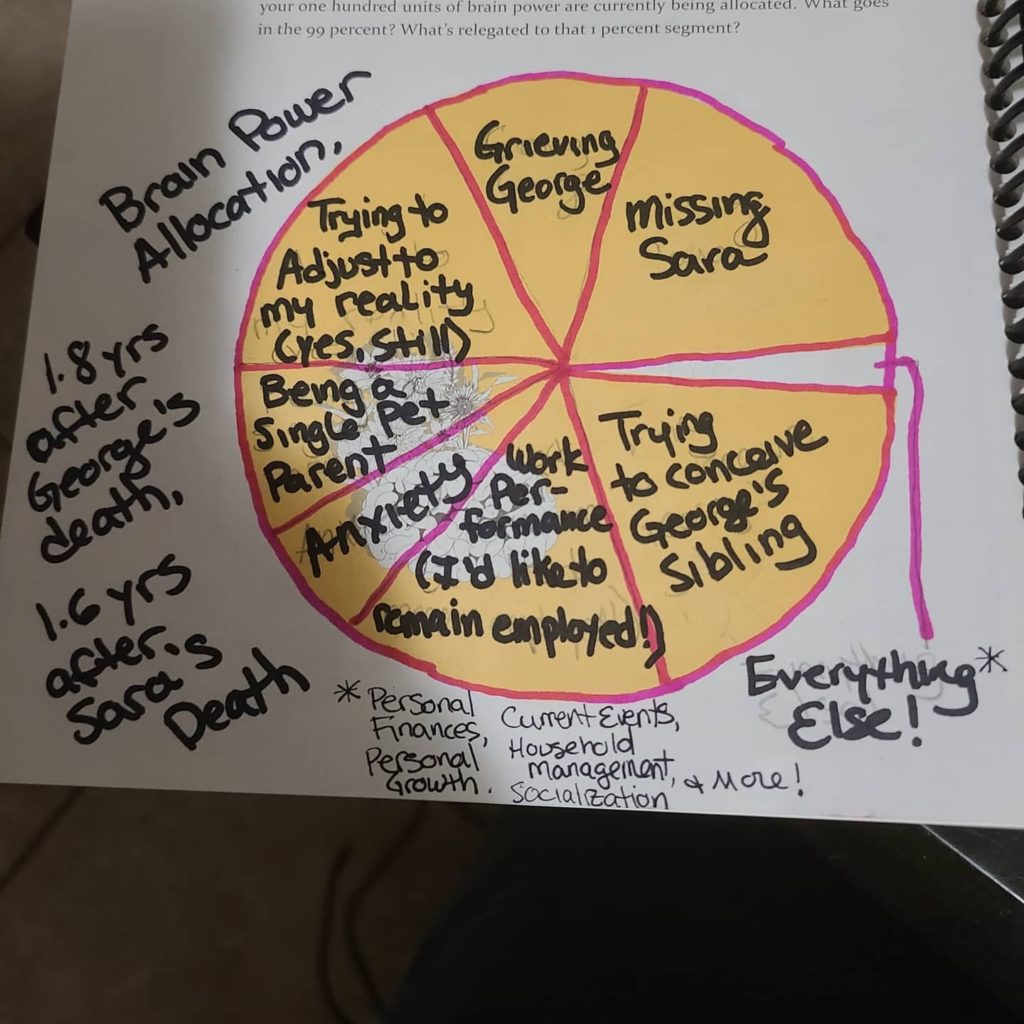Two more exercises in this post from Megan Devine’s grief journal, How to Carry What Can’t Be Fixed.
I’ve talked before in various blog posts about some of the things I told myself, to make it easier to live with my grief (especially early on). This exercise had me think about & write down my personal rules for survival. They’re still applicable, but they were particularly important early on.
- I am allowed to cry whenever/wherever I need to. I’ve cried in doctor’s waiting rooms, after IUI attempts, in the grocery store, in the car, watching tv, cuddling with the dogs, at work, on public transportation – and probably lots of other places I’m not thinking about. Especially early on, I just needed to cry – a lot. I still cry now, but not as often. Sometimes I think it would feel better if I cried more; few things have the same release power as that of a good cry.
- I am allowed to tell people what is/isn’t helpful in my grief. I’m not as good at this as I could be, but there have been a few times I’ve tried specifically to address responses to my grief that are not helpful.
- I am allowed to be truthful when people ask “how are you?” – I’ve written about this before, as well. This is a really hard question, especially early on. I found go-to responses that allowed me to feel as if I were being truthful, but that didn’t necessarily open myself up to follow-up questions if I weren’t feeling like it (think things like “hanging in there”).
- I can keep or get rid of anything I want, at my own pace. I’ve gotten rid of some of Sara’s things, but there are a lot of things I just want to keep, and I am happy with my home the way it is now – a very obvious blend of both her and I still. There are some things I feel like I will need/want to deal with eventually (like her glamour cave), but I still haven’t been able to bring myself to do so, and that’s OK.
- I am allowed to seek distractions; I am also allowed to sink into my grief. Sometimes I just need a mindless distraction… sometimes I need to fully feel my grief. I need both of these experiences, and neither one is inherently good or bad. Both are an important part of learning to carry my grief.
- I am allowed to seek both connection and/or solitude when needed/wanted. Much like the above, both connection with others and time in solitude are critical for my learning to carry my grief. I’ve tried to be flexible, and say Yes to opportunities when I think the connection might be one that nourishes me, but also allow myself to say No when I just need to be alone, or when the connection opportunity doesn’t feel nourishing.
- My grief is not a problem; I will live in a way that honors that truth. This is the core rule that underlies all of the above. It is why I decided to share my writing in the first place, and I’m so glad I latched onto this core rule for myself early on.
Now that I’m almost 2 years out from George’s death and 19 months out from Sara’s my grief has certainly shifted. My last post talked about how my grief manifests for me – mentally/emotionally and physically. Even now, I’m still finding that my brain is nowhere near what it was in the “Before”. We really do have a limited amount of brain power to use each day, and I’m still using a surprisingly large amount of it to cope with the situation I found myself in. Here is a rough example of what came to mind when I tried to think about how my brain is currently functioning:

Early on, the pie chart looked very different. Much more allocated to missing Sara and grieving George, and to trying to adjust to my reality. Much less on work performance and trying to conceive. Today this can vary a lot from day to day. I have days where my grief doesn’t take up as much of my brain power (for whatever reason) and then I have days where it’s even more than I’m showing here. There’s also the fact that I can multi-task – I may be doing other things (working, spending time with the pets, playing a game, etc.) but somewhere in the background my grief and the mental processing to deal with that is still going on.
I’m not really sure the entire point of sharing all this, but I guess I just wanted to 1) make sure other grievers know they aren’t alone if they find it hard to spend energy on anything other than grief, 2) share my personal grief rules that helped me, and 3) give people another glimpse into the fact that no matter how well I may seem to be doing or how highly I’m functioning, there is still a LOT of energy being shifted to things that used to take up virtually no real estate in my brain, in my “Before”. I hope that in the long run I can continue shifting things, naturally, working with my grief and my self so that the grief is running a bit more efficiently and allowing me to use my brain for other things more often – but getting back to “normal” from my “Before”? That’s never going to happen. I wouldn’t want it to, even if it could. That would be a violation of my core rule mentioned above – my grief is not a problem to be fixed.
I love this!